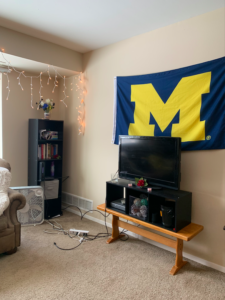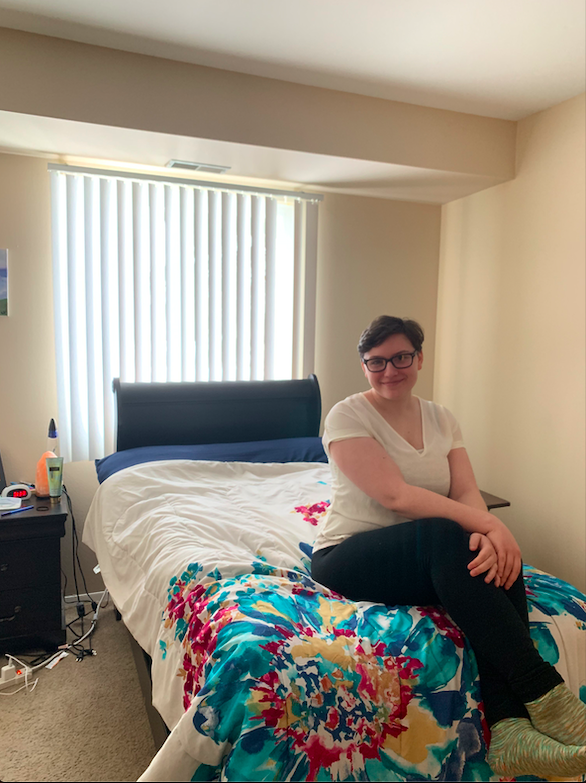Is Housing Becoming a Luxury at UM?
Cheyanne Killin shares her story
—By Katia Flores
The warm weather on February 1st was a pleasant relief for all Michiganders, as it was a sign that the winter storm Jayden had passed through the Midwest. I commuted about 30 minutes by car from my dormitory on campus to a small, secluded apartment complex in the neighboring city of Ypsilanti, Michigan. As I slowly moved further away from campus, the thought of this commute being a part of some students’ day-to-day routines was unsettling.
I had the pleasure of meeting with Cheyanne Killin, a sophomore in the school of LS&A at the University of Michigan, in her two-room apartment. I decided to drive to Ypsilanti instead of meeting her at a coffee shop just to get a sense of what the commute is like for her. I traveled about 7 miles; there was moderate traffic and parking was relatively easy to find around her complex. Admittedly, I could not help but to think to myself how tiring this daily process must be. On top of being a double major in Women’s Studies and Political Science and a Community Action and Social Change (CASC) minor at a top university, she has to worry about gas and bills.
Her Story
I was greeted with a loud, “Welcome to Ypsilanti!” and a warm hug from a familiar face when I arrived. She had recently cut her long, wavy hair into a short pixie cut, so I was caught off guard by the change of look. Cheyanne and I met in the summer of 2017. We were both selected to take a summer semester here at the University of Michigan through a program called the Comprehensive Study Program (CSP). We created many fond memories together but, because of her living situation and her recently-ended relationship with her boyfriend, many of her friendships have “fizzled.”

Cheyanne fell victim to what many low-income students fall into semester after semester instead — expensive off campus housing. “Originally, I was supposed to live in Couzens Hall. I had my room picked out and I was set for the fall semester,” she said. “But I received a revised award letter in the summer and noticed that a good chunk of my grant money was taken away and replaced with student loans — I realized that I could not afford to live in the dorms anymore.” A standard double within university housing costs upwards of $11,534 while a single costs about $13,766 — the price is then split for each term during the academic year. Without her financial aid that would have originally covered it, Cheyanne was left with no other option but to search for off campus housing in Ann Arbor. She began searching for an apartment with her then-boyfriend, who she asked to keep confidential. “The cheapest we could find here in Ann Arbor for a one bedroom apartments was upwards of $1,200 a month, not including the security deposit we had to give.” Her only option at that point was to look outside the bounds of Ann Arbor, which is how she landed an apartment in Ypsilanti.
Cheyanne pays about $890 a month in rent for her two-bedroom apartment and put down a $900 security deposit. At the time, she had her boyfriend to split the costs of living and miscellaneous things such as Wi-Fi and the renter’s insurance bill, but since has moved, the burden of the apartment falls entirely on Cheyanne. Because of her lease, she was not able to move out and find housing elsewhere. Her family is not able to help with major cost of living expenses, and are only able to buy things she absolutely needs. Even her Christmas gifts are exclusively for apartment, such as cups, pans, and even some warm fuzzy socks for the cold winter.
Loans are typically the go-to for students looking to rent an apartment, so it was no surprise when Cheyanne disclosed the large amount she has taken out for housing—I was left shocked. She asked that I keep the amount confidential. “I’ve also racked up about $1,000 in credit card debt just on things for the apartment,” she says. “Budgeting my weekly expenses such as gas and groceries is also very crucial.” The massive responsibility that comes with living alone, paying rent, being a full-time student, and also working, all at the age of 19, is overwhelming.
Day to Day Life
Cheyanne works at a boutique inside Briarwood Mall averaging about 12-16 hours a week. She drives her trusty, but run-down 2005 Grand Jeep Cherokee, and says she typically “runs through a tank of gas each week, which costs about $30-35 to refill. The engine is a bit rusty.”
It’s critical that she leaves her apartment no later than 9am every day in order to avoid morning traffic; she then drives to north campus and parks her car, which is about 45 minutes away from her apartment. She then takes the MBus down to central campus, which is where all her classes are located. Her days usually range from 8:30am until 6pm. This is her daily routine.
To study, Cheyanne usually works at the Duderstadt on North Campus, sometimes as late as 3am. “One night I was back to my apartment close to 4am, which meant I got about four hours of sleep. Those nights are reserved for when I have big exams coming up, though.”
“Because a lot of my friends do live on central campus, they don’t usually want to make the trek out here and vice versa, so I hardly see them. The dishes can sometimes pile up, especially when I’m really busy with classes and work. I have to remind myself to take the trash out, or clean the kitchen. Some days are better than others, I suppose. I’m just trying my best to cope with everything,” she says.
After a brief moment of silence, I noticed Cheyanne gathering her thoughts. I could tell by the look in her eyes that she had a lot on her mind. She let out a strong exhale and simply said, “I feel overwhelmed.”
What the Numbers Say
According to the Department of Numbers, Ann Arbor’s median monthly gross residential rent in 2017 was $1,062 – the highest it’s been since 2005. To put this into perspective, the state of Michigan’s median gross rent was $835, and the US median gross rent was $1,012. What might be the cause of such high rent? Aside from the low crime rate and Ann Arbor’s frequent ranking on best cities list—the “No. 1 place to live because of its civic engagement and education” in 2018 according to MLive.com— it is safe to assume that the increasing influx of wealthy students to the Ann Arbor area every year raises the competition for housing, which results in higher rent for other students. “The median family income of a student here at the U is about $154,000…about 66 percent of students come from the top 20 percent of the income distribution, while 9.3 percent of the student body come from the top 1 percent of the income distribution alone.”
“The University prioritizes the people who give them the most money, and sometimes it sucks because you feel like you have to fend for yourself,” Cheyanne commented.
The exclusive production of these high rise buildings such as Zaragon, the Collegian, Sterling Arbor Blue, etc. reflects the growing average income and contributes to the increasing rent averages, as there is more competition for rental housing. Thus, this excludes those that fall under as low-income, making finding affordable housing for low income students an inevitable obstacle they must face when they decide to do so.
Cheyanne believes that a viable option for this issue is building income reserve housing for students by the University or the city of Ann Arbor whose families make less than $65,000 a year. “ It would lessen the amount of loans students would have to take out in the long run. There’s something similar being constructed in Jackson, Michigan where 154 units are set up for mixed-income couples and low-income senior citizens. I think given this option for students would alleviate so much stress for us”, she says.
4.3% of incoming freshman fall under the income range of 0-$30,000, 2.7% fall under the $30,000-$48,000 range, and 3.9% fall under the $48,000-$75,000 range. To help alleviate the cost of tuition for these lower income students, the University has implemented the Go Blue Guarantee which offers free tuition to admitted, in-state students whose families make under $65,000 a year. They will cover full undergraduate tuition and mandatory university fees for up to four years for students. Housing is not included, but sometimes extra scholarships and grants can cover the remaining cost. The Go Blue Guarantee was approved in June 2017, after Cheyanne had been accepted.
Final Advice
When I asked Cheyanne for her advice to those looking for off campus housing she suggested two things: one, don’t be opposed to looking in Ypsilanti. It is usually cheaper to live in Ypsi and gas isn’t as expensive. Two, make sure you can study in your apartment! On days when it gets especially cold out, or you just don’t feel like driving to the library, you’ll be stuck at home, so she suggests making it as cozy as possible! Additionally, contrary to popular belief, it’s actually better to wait to sign your lease. Typically prices go down after around the springtime and you can get a cheap sublet for as low as $850.
Lauren Schandevel, a senior studying Public Policy at U of M started a 120-page running google doc called Being Not Rich at UM that can be edited by anyone to give in-depth advice to those who feel marginalized by their socioeconomic status, or need help navigating the college life as first generation students. This includes topics ranging from employment, housing, and even how to manage your finances. All that being said, it’s important to remember that although low-income students here at the U are a small minority, they have earned their spot and deserve to be here.
Cheyanne is looking to live with two other roommates closer to campus for the upcoming semester and hopes that her experience and expertise can help guide them as they navigate “adulting”: paying rent on time, keeping up with laundry, and taking the trash out regularly. For now, Cheyanne resorts to her life of running back and forth between Ypsi and Ann Arbor and trying to make it the best possible.
Feature photo: Cheyanne Killin in her apartment in Ypsilanti, by Katia Flores

